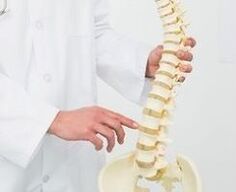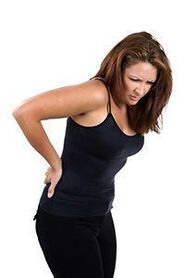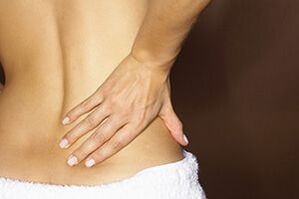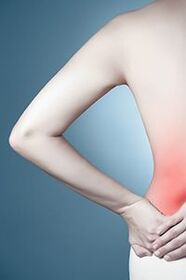Osteochondrosis of the lumbosacral region is intervertebral disc disease in the lower back, the cause of pain in the lower back, buttock, and leg.
intervertebral disc disease in the lower back, the cause of pain in the lower back, buttock, and leg.
Pain syndromes in this disease are diagnosed as radiculitis, lumbar neuralgia, sciatica, lumbago, lumbodynia.Pain-relieving ointments and compresses for these syndromes bring only a temporary effect.This is not always inflammation, but always compression of the nerve root in the lumbosacral region.
The effectiveness of treatment of lumbar osteochondrosis in our clinic exceeds 96-97%.This means lasting, positive results that last a long time.

Why are ointments and blockades dangerous for osteochondrosis of the lumbar spine?
Anesthetic blockades give a more pronounced effect, but have the same disadvantage as ointments.They do not eliminate the disease, but only affect the symptoms.This is their danger.After all, the process of disk destruction continues at the same speed.Over time, the risk of hernia and disability increases.Disorders of the genitourinary system are added, impotence in men, gynecological problems in women.
Pain is not the most dangerous thing with lumbar osteochondrosis.Much more dangerous are its complications, from which neither ointments nor pain-relieving blockades protect.The only remedy against them is complex treatment using reflexology and physiotherapy methods, including acupressure and acupuncture.
Osteochondrosis and disease factors
Osteochondrosis of the lumbosacral region means changes in the intervertebral discs that occur in several stages.The main reasons for these changes are lack of nutrition and high stress.Normal metabolism ensures the renewal of connective tissues as they wear out.Its slowdown and deterioration means that the disks do not have time to update, their structure and properties are damaged.

The main factor in the development of the disease is a sedentary lifestyle, chronic muscle tension and persistent muscle spasms in the lower back.The inflow and outflow of blood in the spine area worsens, and stagnation occurs.The discs are deprived of normal blood supply, collagen and oxygen, and their metabolism deteriorates.
In addition, a sedentary lifestyle significantly increases the load on the spinal discs in the lumbosacral region.
The second most important factor is excess weight.It significantly increases the pressure on the intervertebral discs and causes muscle spasms, tension, stiffness, and muscle rigidity.When lying down, the weight stops putting pressure on the discs, but muscle spasms persist and continue to create stress.
The age factor also matters.In older years, general dehydration occurs.Connective tissues, including intervertebral discs, lose moisture, dry out, and lose shock absorption.This explains the gradual decrease in height in older people.
Stages of osteochondrosis of the lumbosacral region, symptoms

The lumbosacral region consists of 5 lumbar vertebrae (L1-L5) and five fused sacral vertebrae (S1-S5).Most often, osteochondrosis occurs at the border of these structures in the L5-S1 segment or in the lower part of the lumbar L3-L5.
At the early, first stage of the disease, gradual dehydration of the discs occurs.Their depreciation decreases, and they become denser, dry out and cope with loads less and less well.Drying of the discs leads to a decrease in the height of the gaps between the vertebrae.The vertebral bodies come closer together.When bending, lifting heavy objects, or sharp turns of the body, moderate pinching of the nerve roots is possible.This causes lower back pain, which goes away relatively quickly.
A draft, cold, sharp wind, or cooling of the lower back can also serve as a provoking factor.Cold causes muscle spasms that tighten the spine, causing pinched nerves and pain.If treatment is started at the first stage, the development of osteochondrosis can be reversed.The problem is that few people begin treatment for lumbar osteochondrosis at this stage.
At the second stage of lumbar osteochondrosis, the pressure on the intervertebral discs becomes so strong that it leads to their protrusion.It's called protrusion.The protrusion of the disc can be directed in one direction, or along the entire circumference.In the first case it is lateral or dorsal protrusion, in the second case it is diffuse protrusion.
At this stage, the pain intensifies, becomes prolonged or constant, aching.Numbness appears in the leg, pain along the nerve - in the buttock, thigh and down to the shin.Sensation in the leg is impaired, there is a feeling of goosebumps, tingling of the skin, coldness in the leg, numbness and coldness in the toes, muscle weakness of the leg.
The most dangerous symptoms occur when the spinal cord is compressed when the disc protrudes in the posterior direction.This is a violation of urination, deterioration of potency, partial paralysis of the leg.In this case, you can no longer delay treatment.
The third stage of lumbar osteochondrosis means the formation of a hernia.If its size is not too large, and there is little or no compression of the spinal cord, the situation can be corrected without surgery.In more severe cases, all that remains is to remove part of the disk.After this, you need to undergo treatment to prevent the formation of a hernia in adjacent segments.
Treatment of osteochondrosis of the lumbar spine
The treatment course for lumbar osteochondrosis includes from 3-4 to 10-11 sessions.Acute pain is relieved in 1-3 sessions.Complex treatment requires more time, but its results last much longer.
To relieve acute pain, the doctor uses manual therapy, acupressure, acupuncture and acupressure with moxas.First of all, he must be sure that there is no serious hernia or compression of the spinal cord.This is indicated by the nature of the symptoms, but to be completely sure, the doctor may prescribe an MRI.
Before starting treatment, the doctor conducts a diagnosis.He asks in detail about the nature of the complaints, after which he conducts an external examination.By pressing on points near the spine, the doctor finds areas of muscle tension, pain, and spasms.After this, he tests neurological reflexes.Depending on the picture of the disease, the doctor uses certain combinations of procedures, acupuncture regimens, and acupressure.
Acupuncture
To treat lumbosacral osteochondrosis, the doctor inserts needles not only in the lumbar region, but also at distal points on the arms, legs, feet, and head.Using acupuncture, it reduces inflammation and swelling when nerve roots are pinched, reduces muscle tension, and improves blood flow.The analgesic effect of acupuncture for lumbar osteochondrosis is not inferior to potent drugs.
Acupressure
Mandatory part of treatment.With the help of Tibetan massage, the doctor relieves muscle tension, relaxes them and facilitates blood flow to the spine.Pain and stress on the intervertebral discs are reduced, and their restoration begins.
Pharmacopuncture
Injections of homeopathic medicines are used for inflammation of a compressed nerve root; they enhance the effect of acupuncture.
Manual therapy
For lumbar osteochondrosis, the technique of traction is used - soft, manual stretching of the spine.It is used only after relaxing the muscles, relieving spasms and tension with acupressure Tibetan massage and acupuncture.
With the help of manual manipulation, the doctor reduces the load on the discs and joints of the spine, improves mobility in the lower back, eliminates nerve pinches and compression, and restores normal blood flow.
Hirudotherapy
Improves blood circulation in the lower back, helps eliminate blood stagnation, reduces inflammation, stimulates metabolic processes.
Moxibustion therapy
Point heating with a cigar or a smoldering cone accelerates the recovery of discs, improves metabolic processes, blood circulation, and has an additional analgesic and anti-inflammatory effect.Heating the needles enhances the effect of acupuncture.
Tibetan herbal remedies
They improve the functioning of blood vessels, blood circulation, the functioning of the nervous system, help with numbness, improve liver function, collagen synthesis, have a chondroprotective effect, accelerate the restoration of intervertebral discs and joints.
Vacuum therapy, stone therapy
These procedures relax muscles well, normalize lymph flow, stimulate blood circulation, complement the effects of acupuncture and acupressure, and increase the therapeutic effect of a complex session.
Shock wave therapy (SWT) can be used at the border of the lumbar and sacral regions.This procedure creates the effect of internal massage, improves blood circulation, relieves pain, reduces inflammation and accelerates the treatment of osteochondrosis.
Results of treatment of osteochondrosis
Treatment of lumbar and lumbosacral osteochondrosis in the clinic gives stable, long-term results:
- significant relief or complete elimination of pain in the lower back, buttock, leg;
- restoration of sensitivity in the foot, leg, elimination of numbness, cold, muscle weakness;
- restoration of lower back flexibility, elimination of stiffness and stiffness of the lower back;
- prevention of paresis, paralysis, impotence and other complications;
- improving the functioning of the genitourinary system.
Positive changes in the intervertebral discs are confirmed by MRI images.To achieve them, we do not use surgical or medicinal methods.
Home and folk remedies for the treatment of osteochondrosis of the lumbar spine
Mention should be made of folk remedies only because many are accustomed to using them for lumbar radiculitis and other manifestations of lumbosacral osteochondrosis.As a rule, this is treatment with heat - compresses, warming, burning ointments, bee stings.
Most often, mustard, hot red pepper, horseradish, garlic, and camphor are used in compresses, warming patches and ointments.Aloe puree or juice can be used as a remedy for inflammation.
Heat reduces muscle tension and reduces stress on compressed nerve roots and intervertebral discs.This explains the temporary relief of pain and improved mobility in the lower back.These drugs do not replace treatment; they are usually used for acute pain attacks.
Vertebral arthrosis with lumbar osteochondrosis
Lumbar spondyloarthrosis and osteochondrosis often arise due to common reasons, and therefore develop in parallel.Osteoarthritis of the intervertebral joints means depletion of cartilage tissue.Like osteochondrosis, it manifests itself as pain in the lower back, which intensifies with movement, lifting weights and other physical activities.But there are some differences in symptoms.
Pain with arthrosis of the vertebral joints can be especially severe after a night's sleep, in the morning, or at the beginning of movements.Such pains are called starting pains.After some time, their intensity decreases.A characteristic symptom of the disease is morning stiffness and stiffness in the lower back.
Joint disease leads to tension and muscle pain in the buttocks, difficulty moving in the hip joints.Symptoms such as numbness and weakness in the legs increase the similarity of arthrosis of the vertebral joints with lumbosacral osteochondrosis.
Treatment methods for these diseases are largely similar.They are aimed at relaxing muscles, increasing blood flow and blood supply to the lumbar spine, and stimulating recovery processes.Collagen is the building material for intervertebral joints and discs.Therefore, treatment of spondyloarthrosis and osteochondrosis includes improving liver function, on which collagen synthesis and its supply to the spine depends.
Nutrition for lumbosacral osteochondrosis
Lumbosacral osteochondrosis often develops against the background of excess weight.This requires individual nutritional correction in combination with other treatment methods.
Lumbar osteochondrosis is a cold disease and is associated with a disorder of the Bad-kan (Mucus) and Rlung (Wind) systems.The imbalance of these systems is associated with exposure and accumulation of cold, so nutrition for lumbar osteochondrosis should provide maximum heat for the body.But at the same time, you should not overload the liver with spicy, salty, smoked, fatty, fried foods.
Raw vegetables, fruits and fruit juices cool the body.These products can be used as a source of vitamins, but only after heat treatment.Sugar and white bread are refrigerated, so it is better to exclude them.Sugar can be replaced with honey if possible.Potatoes, like other cooling foods, can be adjusted with ghee, garlic, spices (nutmeg, turmeric, ginger, cinnamon, black and red hot pepper).
Quail and chicken eggs are warming, so they can be consumed for lumbar osteochondrosis.Hard, aged cheeses, ghee, and poultry are recommended.The healthiest product is fish, especially fatty salmon.In addition to the fact that fish is ideal for warming and helping with Mucus and Wind disorders, it additionally strengthens and restores intervertebral discs and joints due to its chondroitin content.Also useful are dishes made from fish and animal connective tissues (cartilage, tendons), bone marrow and bones, including rich broths, jellied meats, and aspic.
















































